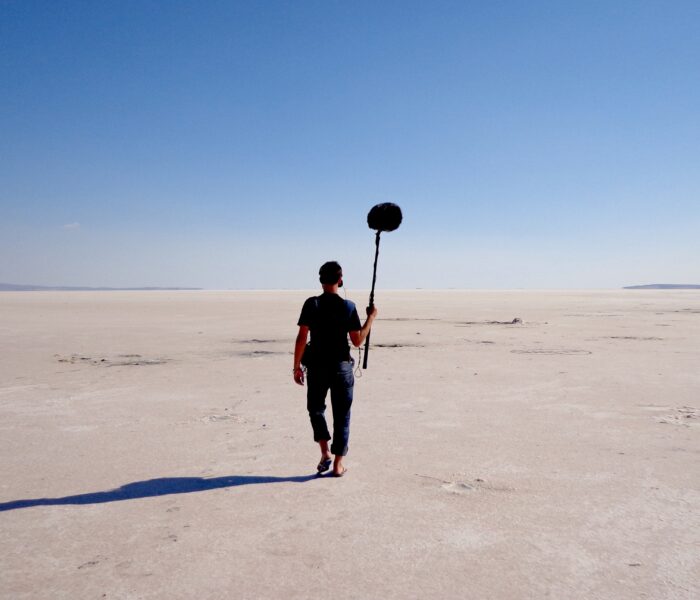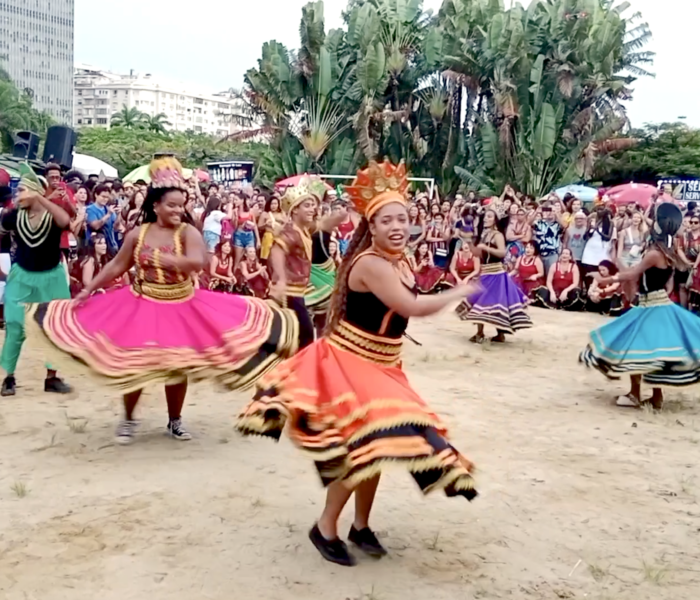Cet automne, Marlene Monteiro Freitas était partout. Dans le cadre du portrait que lui consacrait le Festival d’automne à Paris, huit de ses créations étaient présentées dans différentes salles de la capitale, de Guintche, un solo métamorphique datant de 2010, à RI TE Paris Intermission, en duo avec le danseur flamenco Israel Galvan, créé à la mi-décembre à l’espace Cardin. Danseuse et chorégraphe – elle a notamment étudié à P.A.R.T.S., l’école qu’a fondée Anne Teresa de Keersmaeker à Bruxelles – le travail de Marlene Monteiro Freitas, à la croisée de la danse, de la performance et du théâtre, peut être décrit comme un bouleversement continu de l’art et des cadres de la scène. Rencontre au milieu des pupitres, dans CATTIVO, l’exposition qu’elle présentait dans la grande halle de la Villette.
Marlene, vous êtes née au Cap-Vert où la tradition du carnaval est encore vivace. Et on ne peut pas ne pas penser au carnaval quand on assiste à un spectacle comme Bacchantes – prélude pour une purge (2017). Les masques, les postures des corps, le rôle qu’y joue la musique, partie intégrante de l’espace scénique au même titre que les danseurs, la pièce ressemble à une longue et étrange procession carnavalesque.
Le carnaval est ma première expérience du mélange. On voit quelque chose d’extrêmement laid à côté de quelque chose d’extrêmement beau, quelque chose de dégoûtant à côté de quelque chose de délicieux. Cette combinaison des contradictoires, on la retrouve dans de nombreux lieux à travers le monde et c’est à chaque fois une expérience nouvelle, une autre manière d’associer les extrêmes. J’aime particulièrement les processions où le funèbre et la célébration vont ensemble. Le triste et le joyeux, le vif et le calme, le silencieux, se côtoient. Quelque chose porte en même temps les contraires. Il y a ça dans certaines musiques. La trompette a cette capacité d’être simultanément festive et funèbre. C’est une force singulière, que j’ai utilisée dans Bacchantes.
Certains gestes et certaines postures présentent aussi cette particularité, cette tension. Ce peut être une manière de marcher, de s’asseoir, de parler. Les voix d’enfants m’intéressent beaucoup pour cette raison. Dans cette installation où nous sommes, il y a un chœur d’enfants qui chante une chanson de Nirvana et il est impossible de savoir si c’est triste ou joyeux. Le théâtre commence ainsi, par un geste, un mouvement. Après il faut le reproduire, l’incorporer, lui ajouter un costume, le tordre peut-être mais surtout préserver cette ambivalence première.

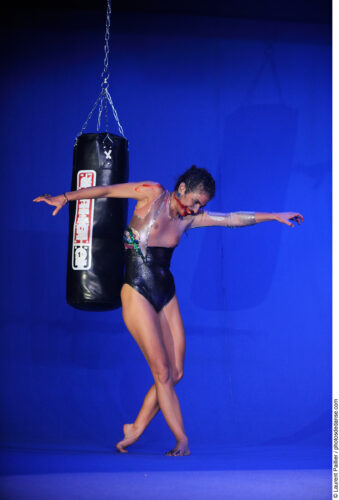
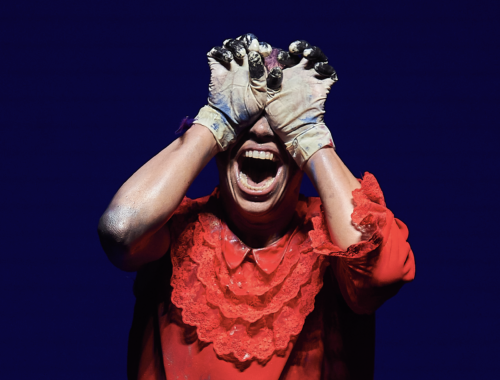
Dans vos spectacles, la musique ne joue presque jamais le rôle d’accompagnatrice qui lui est généralement dévolu dans les ballets classique et moderne. Elle est un personnage ou un objet, elle fait partie du drame. Quelle est sa fonction dans vos chorégraphies ?
La musique agit. Elle a le pouvoir de modifier une scène, de colorer une atmosphère, d’intensifier une action, de mettre quelque chose sous les yeux, d’interrompre. Elle est aussi vivante que les corps sur le plateau. C’est pour moi un des éléments les plus importants de la dramaturgie d’un spectacle. Mais il y a la musique et il y a la musicalité. Ce sont deux choses différentes. D’un côté il y a la pièce, cette fiction globale que l’on construit sur scène et qui a son rythme propre et de l’autre il y a des corps, des musiques, des mouvements, des costumes, tous les éléments qu’il faut assembler pour faire un spectacle. Au-delà des musiques qu’on entend, et même si la musique est tout le temps présente, ce qui est rare mais qui peut arriver, il y a la musicalité de la pièce, sa rythmicité, la manière dont elle respire, dont elle se pose, dont elle regarde. C’est un être vivant qui demande et qui donne. Il y a une inspiration et une expiration, qui incluent le public. La musicalité contient tout et réunit tout, le public aussi. Si elle n’agit pas sur lui, si elle ne l’inclut pas, quelque chose ne fonctionne pas.
Dans Bacchantes, il y a une musique qui fait irruption dans la pièce de manière tout à fait imprévisible, c’est le Boléro de Ravel. Et d’un coup, il transforme la scène et réoriente le drame. Comment s’est-il imposé à vous ?
Le Boléro interrompt une action en cours mais vient en même temps renforcer quelque chose qui était en train de bouillir lentement depuis plusieurs minutes et l’aide à se révéler, à prendre forme. Une autre musique importante dans Les Bacchantes est la Sequenza X de Luciano Berio, pour trompette solo. Elle agit d’une tout autre manière, un peu comme un personnage alors que le Boléro correspond plus à un changement de scénographie. Tout d’un coup on change de décor.
Quand je travaille sur un projet, je fais de grandes playlists de toutes les musiques que je lui associe, quel que soit leur genre ou leur distance apparente du sujet. Toutes ne feront pas partie de la pièce mais elles informent toutes le travail en cours. Je joue les playlists en mode aléatoire et j’essaie de sentir les liens, les agencements, j’attends d’être surprise ou émue.
L’histoire qui m’a menée au Boléro est intéressante. J’arrive dans une résidence d’écriture et de préparation pour Bacchantes. Je suis seule dans un grand studio et je mets une des playlists en mode aléatoire. Puis je regarde l’espace autour de moi et je me dis que ce n’est pas le bon espace, celui dont j’ai besoin pour travailler. Il est trop ouvert, trop vide. Il manque quelque chose. Donc je commence à fermer l’espace, à l’occuper avec des objets et des meubles. Je me retrouve à porter une énorme enceinte et, à ce moment-là, le Boléro se met à jouer. Je regarde l’enceinte. Elle est debout devant moi et j’ai l’impression que c’est elle qui me chante la musique, qu’elle veut danser et qu’en la portant je pourrais danser avec elle et avec toutes les autres choses dans la pièce. C’est comme si la musique et les objets s’étaient mariés. Une connexion s’est faite. Quelque chose s’est imposé. Et cela m’a tout de suite fait penser à ce passage de Bacchantes d’Euripide où les femmes quittent la ville pour aller dans la forêt.
Nous sommes actuellement dans la grande halle de la Villette, entourés des pupitres de CATTIVO, l’exposition que vous y avez installée. Une exposition de pupitres qui prennent une multitude de formes et jouent des dizaines de personnages. Il y a une maternité, une école, un régiment, des funérailles, un cinéma, etc., une assemblée, des expériences de laboratoire et une scène musicale qui s’active à intervalles réguliers. Pourquoi avoir choisi cet étrange matériau ?
Les pupitres faisaient partie de la scénographie de Bacchantes. Je les préparais avant chaque représentation et j’aimais beaucoup leur donner différentes formes qui en faisaient de quasi-personnages. Mais c’était un spectacle et je ne voulais pas encombrer la scène. L’idée est restée et, plus tard, j’ai eu envie de la reprendre et de la développer, d’en faire une installation. Mais c’est grâce à Euripide que j’ai commencé à les démembrer. Il y a en eux une musique que je cherchais à faire sortir, en les torturant un peu, mais avec douceur.
Quand j’étais petite, je ne savais pas comment ouvrir un pupitre. À chaque fois, il me mordait les doigts. J’avais mal, je lui en voulais. Mais je savais qu’il ne cherchait pas à me faire du mal. Et j’ai fini par les apprivoiser. Je cherche à construire avec les choses, mais aussi avec les musiques, une relation qui ne ferme pas l’imaginaire, qui l’ouvre.
J’ai été marqué par Les statues meurent aussi, le film de Chris Marker et Alain Resnais. Leur manière de filmer les statues m’a beaucoup touché. Ils sont parvenus à les rendre vivantes. Elles nous regardent. C’est ce que je voulais faire ici : que l’objet nous regarde.
Je fais la même chose avec la musique. J’aime sa plasticité. C’est comme une pâte à modeler. J’ai du mal avec les choses trop dures ou trop rigides. Par exemple, il est très difficile pour moi d’être devant une sculpture que je ne peux ni casser, ni toucher, ni même déplacer d’un centimètre. Je n’arrive pas à me relier. Quand j’écoute de la musique, je la modèle et quelque fois elle me modèle aussi. C’est le cas avec Bach.

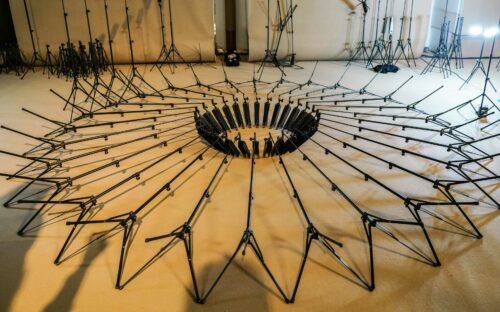
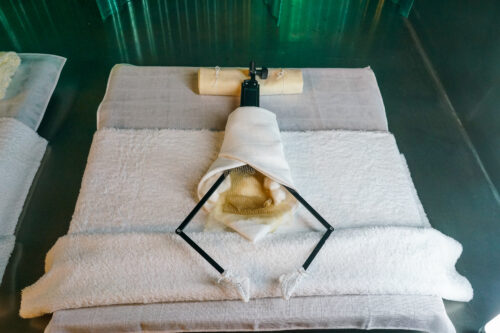
Vous avez présenté fin novembre dans la grande halle de la Villette une mise en scène du Pierrot lunaire d’Arnold Schönberg avec les musiciens de l’ensemble Klangforum Wien et la chanteuse Sofia Jernberg dans le rôle de la récitante (une pièce qui fut créée en 2021 à Vienne). Vous avez fait de tous les musiciens, chanteuse comprise, des personnages d’un drame mystérieux. Ils sont costumés, les musiciens en soutanes boutonnées dans le dos, et Pierrot en habit et coiffe de cardinal. Comment avez-vous abordé ce projet ?
Une des premières questions que je me suis posé en voyant les musiciens de l’Ensemble jouer Pierrot lunaire, c’était, à chaque chanson, qui joue et qui ne joue pas ? et que fait le musicien quand il ne joue pas ? pourquoi ne s’extrairait-il pas du groupe pour faire autre chose ? Et quand je me posais la question, quelque chose se passait dans mes oreilles, un rééquilibrage. Je devenais attentive à des choses infimes, que je n’avais jamais entendues jusque-là. Je me suis dit que si je rendais cela visuel, qui joue et qui ne joue pas, cela nous rapprocherait des musiciens et donc de la musique. Car ce sont eux qui nous permettent d’accéder à la complexité de l’œuvre. Ils sont notre porte d’entrée.
Par la suite, j’ai étudié l’œuvre dans le détail, de l’intérieur : la relation des poèmes avec la musique, quelle forme musicale et quel groupe instrumental correspond à chacun et pourquoi, leur ordre, les pauses, la longueur des pauses, etc. J’ai essayé de ne rien laisser au hasard. Mais ma mise en scène est restée fidèle à cette première question. Qui joue ? Cela m’a permis d’inclure les musiciens dans le spectacle. Ils n’étaient plus seulement des interprètes, ils devenaient aussi des personnages. Pierrot, c’est la chanteuse, Sofia Jernberg dans la pièce. Son incarnation de Pierrot est extraordinaire. Mais je voulais que l’ensemble interprète la musique comme s’ils étaient tous aussi des Pierrot. Plus j’étudiais la pièce, plus j’avais l’impression qu’il y a chez lui un désir refoulé, une culpabilité profonde qui réprime son désir. C’est une des raisons pour lesquelles j’ai choisi ces costumes. Mais il ne s’agissait pas de dévoiler un sens caché. La musique dit déjà tout ce qu’il y a à dire. Les poèmes d’Albert Giraud sont assez hermétiques, ils fourmillent de métaphores étranges, mais la musique de Schönberg les rend limpides.
Il y a quelques jours, vous avez créé au Théâtre de la Ville, Espace Cardin, un duo avec le danseur de flamenco Israel Galvan, RI TE Paris Intermission. Vos univers esthétiques et chorégraphiques sont on ne peut plus différents. Comment avez-vous travaillé ensemble
Nous avons monté RI TE en quatre jours. C’est encore un work in progress. Je ne danse pas le flamenco et je n’ai pas appris à le danser pour cette pièce. Mais ça n’a pas été un problème. Il s’agissait de revenir à la source du geste flamenco, au principe de son mouvement si singulier. Trouver l’énergie qui précède la forme. C’est ce que veut dire Israel Galvan quand il dit que Michael Jackson pourrait être un danseur de flamenco. Parce qu’il y a dans son mouvement et dans son corps cette énergie-là. En ce sens, n’importe qui peut danser le flamenco, même moi. Et c’est ce que j’ai fait, à ma manière.
La chorégraphie est comme une langue. Elle a des accents, une grammaire, un lexique. Quand je danse avec Israel Galvan, je dois comprendre un peu sa langue et lui doit comprendre un peu la mienne. On se traduit mutuellement et on se trompe, on mélange les mots, on invente des phrases qui ne veulent rien dire. On a beaucoup travaillé sur la contrariété des gestes. Par exemple, il me souffle un baiser avec passion et moi je crache par terre avec dégoût. C’est un des motifs récurrents du spectacle.
Quand je travaille sur un projet, je défends toujours l’idée que, malgré l’écriture et ce qu’on pourrait appeler la rigueur de la forme, il y a des endroits et des moments où l’on peut aller ailleurs, en profondeur plutôt qu’en surface et ce voyage n’a pas de limite. Entre un point A et un point B, on peut aller très loin dans la profondeur mais on peut aussi sauter très haut. Entre ces deux points, l’espace est infini. C’est aussi l’espace du danger. Mais c’est là qu’on muscle l’imagination, car l’imagination est un muscle qu’il faut entraîner. Quand on prépare une pièce, on va au gymnase de l’imagination et la ligne entre A et B devient un monde qui s’ouvre.
Une question traverse plusieurs de vos spectacles, je pense à Mal-Embriaguez Divina (2020) mais aussi, dans une certaine mesure, à Guintche (2010), celle de l’oppression des corps, qu’elle soit politique, sociale ou raciale, et des manières dont ils s’y opposent et résistent. La musique n’y joue pas tout à fait le même rôle. Peut-elle faire le mal de la même manière qu’elle fait le bien ?
Quand je dis que la musique agit, cela ne veut pas dire qu’elle agit toujours dans le bon sens. Elle n’est pas toujours douce et bienfaisante. Elle peut être violente, elle peut asservir, elle peut servir des causes mauvaises et des régimes injustes. Mais, même là, elle m’intéresse.
Il y a quelque chose du geste humain qui me touche infiniment, du côté du bien comme du côté du mal. Il peut me mettre en douleur ou en joie. Mais, aussi diabolique soit-il, il est humain et il m’intéresse, comme le geste bon, qui est aussi intrigant finalement. Et quand les deux se rencontrent ou se confondent, ça m’intéresse encore plus. Car cela produit une déflagration. Je ne cherche pas à résoudre la contradiction, je la provoque, je l’expose, je la mets en mouvement et en corps.
Et ce qui vaut pour le geste vaut aussi pour la musique. J’aime quand des musiques très différentes s’entrechoquent sans s’harmoniser ou s’entendre. Comme Ravel et Berio ou Schönberg et Sinéad O’Connor**. Il y a dans chaque corps humain et dans chaque tête humaine des musiques et des danses contradictoires. Je me contente de les révéler.
Auriez-vous un souvenir d’enfance qui soit lié à une musique ?
Je me souviens d’une chanson qui a été écrite au moment de l’indépendance du Cap-Vert*. Les premiers vers disent « Labanta braço grita bô liberdade / Grita povo independenti / Grita povo libertadu », « Lève le bras et crie pour ta liberté / Crie, peuple indépendant / Crie, peuple libéré ». À chaque fois qu’on entendait cette chanson, cela produisait quelque chose de très fort, de très physique. Nous étions tous emportés.
Propos recueillis par Bastien Gallet
* « Labanta Braço », du musicien et compositeur capverdien Alcides Spencer Brito. La chanson est écrite dans la langue créole de l’île de Sal, où il habitait.
** Pierrot lunaire s’ouvre avec Nothing Compares 2 U de Sinéad O’Connor.
Photos © Bob Lima
Photos © Laurent Paillier
Photos © José Caldeira
Photos © José Frade



)

